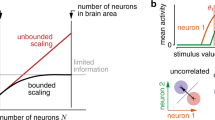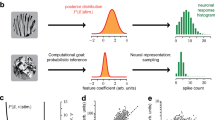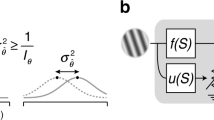Abstract
SINGLE neurons can signal subtle changes in the sensory environment with surprising fidelity, often matching the perceptual sensitivity of trained psychophysical observers1–10. This similarity poses an intriguing puzzle: why is psychophysical sensitivity not greater than that of single neurons? Pooling responses across neurons should average out noise in the activity of single cells, leading to substantially improved psychophysical performance. If, however, noise is correlated among these neurons, the beneficial effects of pooling would be diminished10–12. To assess correlation within a pool, the responses of pairs of neurons were recorded simultaneously during repeated stimulus presentations. We report here that the observed covariation in spike count was relatively weak, the correlation coefficient averaging 0.12. A theoretical analysis revealed, however, that weak correlation can limit substantially the signalling capacity of the pool. In addition, theory suggests a relationship between neuronal responses and psychophysical decisions which may prove useful for identifying cell populations underlying specific perceptual capacities.
This is a preview of subscription content, access via your institution
Access options
Subscription info for Japanese customers
We have a dedicated website for our Japanese customers. Please go to natureasia.com to subscribe to this journal.
Buy this article
- Purchase on SpringerLink
- Instant access to full article PDF
Prices may be subject to local taxes which are calculated during checkout
Similar content being viewed by others
References
Mountcastle, V., Talbot, W., Sakata, H. & Hyvarinen, J. J. Neurophysiol. 32, 452–484 (1969).
Mountcastle, V., LaMotte, R. & Carli, G. J. Neurophysiol. 35, 122 (1972).
Johnson, K., Darian-Smith, I. & LaMotte, C. J. Neurophysiol. 36, 347–370 (1973).
Johnson, K., Darian-Smith, I., LaMotte, C., Johnson, B. & Oldfield, S. J. Neurophysiol. 42, 1332–1353 (1979).
Tolhurst, D. J., Movshon, J. A. & Dean, A. F. Vision Res. 23, 775–785 (1983).
Bradley, A., Skottun, B. C., Ohzawa, I., Sclar, G. & Freeman, R. D. J. Neurophys. 57, 755–772 (1987).
Hawken, M. J. & Parker, A. J. in Vision: Coding and Efficiency (ed. Blakemore, C.) 103–116 (Cambridge Univ. Press, Cambridge, 1990).
Vogels, R. & Orban, G. A. J. Neurosci. 10, 3543–3558 (1990).
Recanzone, G. H., Merzenich, M. M. & Schreiner, C. E. J. Neurophysiol. 67, 1071–1091 (1992).
Britten, K. H., Shadlen, M. N., Newsome, W. T. & Movshon, J. A. J. Neurosci. 12, 4745–4765 (1992).
Johnson, K. J. Neurophysiol. 43, 1793–1815 (1980).
van Kan, P., Scobey, R. & Gabor, A. Expl Brain Res. 1985, 559–563 (1985).
Newsome, W. T. & Paré, E. B. J. Neurosci. 8, 2201–2211 (1988).
Salzman, C. D., Murasugi, C. M., Britten, K. H. & Newsome, W. T. J. Neurosci. 12, 2331–2355 (1992).
Murasugi, C. M., Salzman, C. D. & Newsome, W. T. J. Neurosci. 13, 1719–1729 (1993).
Worgotter, F., Daunicht, W. & Eckmiller, R. J. Neurosci. Meth. 17, 141–151 (1986).
Zeki, S. M. J. Physiol., Lond. 236, 549–573 (1974).
Anderson, T. An Introduction to Multivariate Statistical Analysis (Wiley, New York, 1958).
Gawne, T. & Richmond, B. J. Neurosci. 13, 2758–2771 (1993).
Newsome, W. T., Britten, K. H., Movshon, J. A. & Shadlen, M. in Neural Mechanisms of Visual Perception. Proc. Retina Res. Fdn (eds Lam, D.M.-K. & Gilbert, C. D.) 171–198 (Portfolio Publishing, The Woodlands, Texas, 1989).
Celebrini, S. & Newsome, W. T. J. Neurosci. (in the press).
Dubner, R., Kenshalo, D. R., Maixner, W., Bushnell, M. C. & Oliveras, J. L. J. Neurophysiol. 62, 450–457 (1989).
Author information
Authors and Affiliations
Rights and permissions
About this article
Cite this article
Zohary, E., Shadlen, M. & Newsome, W. Correlated neuronal discharge rate and its implications for psychophysical performance. Nature 370, 140–143 (1994). https://doi.org/10.1038/370140a0
Received:
Accepted:
Issue Date:
DOI: https://doi.org/10.1038/370140a0



